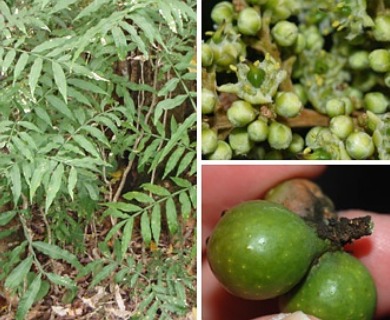Wingleaf Soapberry
Sapindus saponaria
Maple family (Sapindaceae)
Native species (indigenous)
This handsome tree is of special interest as one of two tree species native to both Hawaii and the continental United States (southern Florida). (The other is ‘a‘ali‘i, Dodonaea viscosa Jacq.). It is characterized by leaves with usually 6–12 paired elliptical to lance-shaped dull green and axis slightly winged when young and by the shiny brown ball-like single-seeded berries 5⁄8–3⁄4 inch (15–19 ) in diameter.

©2013 Eric White
Leaves 8–16 inches (20–40 ) long. stalkless or nearly so, 2 1⁄2–5 inches (6–13 ) long and 3⁄4–1 1⁄2 inches (2-4 ) wide, long or short-pointed at base short-pointed or blunt and often oblique and unequal with side toward leaf broader, not on edges, thin, upper surface dull green and hairless, lower surface slightly paler and sometimes soft hairy.
Flower clusters () and lateral, to 4–8 inches (10–20 ) long, larger elsewhere, very numerous small 5-parted whitish flowers 3⁄16 inch (5 ) across, mostly male but some female or (polygamous). Male flowers have five spreading unequal about 1⁄16 inch (1.5 ) long, outer two smaller, whitish and tinged with green; five white hairy rounded petals smaller than eight light yellow more than 1⁄16 inch (1.5 ) long on a light green and minute brown nonfunctional Female flowers have petals, shorter and greenish more than 1⁄16 inch (1.5 ) long with three-celled and slender
(berries or cocci) are in clusters on hard woody stalks, single (sometimes two or three), developing from a and others -like at base, with leathery shiny brown skin and yellow sticky bitter poisonous flesh, clear or translucent. Seed single, round, black, 3⁄8–1⁄2 inch (10–13 ) in diameter, poisonous.
Sapwood is whitish and heartwood yellow or light brown. Wood hard and heavy ( gr. 0.8), coarse-textured, and not durable when exposed. Elsewhere used for posts and in carpentry.
The scientific and common names refer to the use elsewhere of the fleshy as a substitute for soap. When cut up, the fleshy part, containing about 30 percent saponin, produces abundant suds in water.
The seeds are used in leis in Hawaii. In tropical America, crushed seeds serve as a fish poison when thrown into a stream. An insecticide has been made from ground seeds, and medicinal oil extracted. Also elsewhere, the hard round seeds have been used as beads in necklaces and rosaries as well as marbles and formerly, as buttons.
A common shade tree in tropical America and classed as a honey plant. Infusions of the roots and leaves have been prepared for home remedies.
Wingleaf soapberry is native in the middle forest zone at 3000–4500 ft (914–1372 ) elevation on the island of Hawaii, for example, Mauna Loa and Puu Waawaa. The trees of largest size are accessible and easily seen in Kipuka Puaulu near Kilauea Volcano within Hawaii Volcanoes National Park. There are also some at Ulupalakua on Maui. Another form is planted in Hawaii as a shade tree.
Special areas
Waimea Arboretum, Wahiawa, Volcanoes, Kipuka Puaulu, Ala Moana Park
Champion
Height 106 ft (32.3 ), c.b.h. 10.1 ft (3.1 ), spread 84 ft (25.6 ). Hawaii Volcanoes National Park, Hawaii (1968).
Range
Widespread in tropical America from northern Mexico to Brazil and Argentina and through West Indies including Puerto Rico and Virgin Islands. Also in Florida and at 2 coastal localities in Georgia, the range extended northward partly by prehistoric Indians and partly by cultivation. Native to Hawaii and other Pacific Islands including the Marquesas and Society Islands to New Caledonia. Introduced into Old World tropics.
The native Hawaiian trees found in 1909 by Joseph F. Rock seemed different from the introduced trees of another form in Honolulu and were named Sapindus thurstonii Rock. Soon afterwards he concluded that the native trees, which have foliage, were the same as the species widespread on the American continent. The segregate was revived by St. John (1977b).
The separate or distribution of this tree species in continental America and also Hawaii and other Pacific Islands is unexplained. However, Degener (1930, p. 202) observed that the dried berries have an air space between the outer wall and seed formed by the shrinking flesh and that they will float in water. Also when removed from the at least half of the seeds will float. Thus, long distance transportation by ocean currents may occur. Seeds are often found in beach drift on various islands. Rock found that the Hawaiian trees attain a larger size, both in height and particularly in trunk diameter, than those anywhere on the mainland.
Other common names
a‘e, manele, soapberry; jaboncillo (Puerto Rico, Spanish)
Botanical
Sapindus thurstonii Rock






